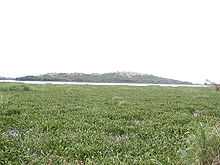Water hyacinth in Lake Victoria

Water hyacinth has become a major invasive plant species in Lake Victoria.
History
Botanists and gardeners carry plants with them in their travels, and experts suspect that this is how the water hyacinth came to the African Great Lakes in the 1980s. As its flowers are reputed for their beauty, it was probably brought over as an ornamental for garden ponds.[1] The consensus is that Water hyacinth entered Lake Victoria from Rwanda via the river Kagera.[2] The exact time and place of introduction has been debated, but the plant is native to South America. It therefore reached Lake Victoria due to human activity. The hyacinth has since spread prolifically, due to a lack of natural predators, an abundance of space, agreeable temperature conditions, and abundant nutrients, including increasing heavy metal pollution in the lake.[3][4]
Water hyacinths increased rapidly between 1992–1998, were greatly reduced by 2001, and have since resurged to a lesser degree. Management techniques include (hyacinth-eating) insect controls and manual beach cleanup efforts.[5] A water hyacinth infestation is seldom totally eradicated. Instead, it is a situation that must be continually managed.[1][6]
There are indications that water hyacinths can provide benefits to the Lake Victoria Region.[7] Water hyacinths have been planted in an attempt to purify eutrophicated water.[8] Once established, the plants can be harvested and used for biogas production,[9] fertilizer, and other things.[8]
Effect
Water hyacinth affects the Lake Victorian population in many negative ways. There are economic impacts when the weed blocks boat access. The effects on transportation and fishing are immediately felt. Where the weed is prolific, there is a general increase in several diseases, as the weed creates excellent breeding areas for mosquitoes and other insects. There are increased incidents of skin rash, cough, malaria, encephalitis, bilharzias, gastro intestinal disorders, and schistosomiasis. Water hyacinth also interferes with water treatment, irrigation, and water supply.[3] It can smother aquatic life by deoxygenating the water, and it reduces nutrients for young fish in sheltered bays. It has blocked supply intakes for the hydroelectric plant, interrupting electrical power for entire cities. The weed also interrupts local subsistence fishing, blocking access to the beaches.[6]
References
- ↑ 1.0 1.1 United Nations News Highlights, "Fighting water weeds in West Africa." Food and Agriculture Organization of the United Nations. 16Aug2000. United Nations. 19 May 2008
- ↑ Ambrose, Philippa . "Water hyacinth chokes lake Victoria." Marine Pollution Bulletin 34. 6Jun1997 364. 29Apr2008
- ↑ 3.0 3.1 Opande, G.O., Onyang, J.C., Wagai, S.O.. "Lake Victoria: The water hyacinth (Eichhornia crassipes [MART.] SOLMS),its socio-economic effects, control measures and resurgence in the Winam gulf." Limnologica 34. 1-2 May2004 105-109.
- ↑ Journal of Industrial Pollution Control, "Water Hyacinth and Duckweed as indicators of heavy metal pollution in River Asa." 29(2)(2013) pp 155-162
- ↑ Kateregga, Eseza and Thomas Sterner. 2007. Indicators for an invasive species: Water hyacinths. Ecological Indicators 7(2):362-370.
- ↑ 6.0 6.1 World Bank. 1996. Kenya, Tanzania, Uganda - Lake Victoria Environmental Management Project. World Development Sources, WDS 1996. Washington, DC: World Bank.
- ↑ V.A. Valk, MSc thesis, Geoscience and Engineering, Delft University of Technology "Valorization of water hyacinth as a renewable source of animal feed and biogas: a business case for Lake Victoria, Kenya" 2015-02-02
- ↑ 8.0 8.1 Huan Jing Ke Xue. " Purification effects of large-area planting water hyacinth on water environment of Zhushan Bay, Lake Taihu" 2011 May;32(5):1299-305.
- ↑ International Journal of Engineering and Technology "Feasibility Study of Biogas Production from Water Hyacinth A Case of Lake Chivero – Harare, Zimbabwe" Volume 3 No. 2, February, 2013
| Wikimedia Commons has media related to Water hyacinth. |